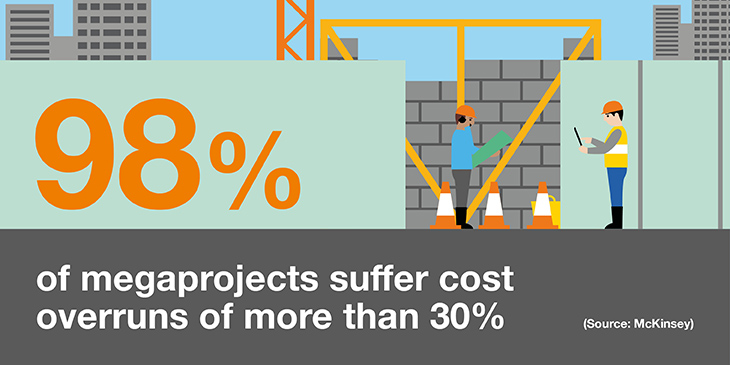Improving construction project cost projections
A few years ago, McKinsey estimated that around 98% of construction industry “mega” projects experience cost overruns of more than 30%, and three-quarters are at least 40% late. These cost overruns tend to fall into the categories of technical challenges, which include scope changes, disagreements between clients, contractors and sub-contractors, labor and material cost increases, inaccurate forecasting, unforeseen events and inadequate monitoring.
As such, construction projects are well-known for running overdue and missing deadlines – but what can digital do about it? To begin with, connected IoT devices can help construction companies with project progress tracking. By equipping site workers with wearable technologies, such as connected sensors on hi-vis vests or hard hats, construction companies can track employee movements to ensure teams are using working time efficiently. Another method is using IoT-enabled management systems to help with keeping track of material deliveries to building sites, helping stay on schedule for deadlines and reducing costs.
Digital twins are another tool that can be a boon to construction companies. A digital twin of a building not yet built can help construction companies test out designs, keep plans on track through simulations and fine-tune operational processes before physical construction begins. It’s an excellent way to ensure efficiency, keep projects on track and keep costs under control.

Tech to catch a thief
Another area where IoT-connected sensors and digital tracking tools can help is theft. According to insurer Allianz Cornhill, thefts from construction sites increased 55% between 2013 and 2018, and typically cost the UK construction industry £800 million a year. The COVID-19 lockdown saw a further spike in theft from construction sites, too, with the UK’s Construction Equipment Association (CEA) reporting an increase of around 50% as sites were left unmanned. Digitally-powered asset tracking can help construction companies mitigate these thefts.
Transforming health and safety on the construction site
According to the Health and Safety Executive, in 2019 the UK construction industry experienced 30 fatal injuries and 54,000 non-fatal injuries, including slips, falls, workers hit by flying or falling objects, and injuries caused when lifting or carrying items on site. Technology could help reduce these numbers.
IoT and sensors in construction have the potential to help reduce accidents. There are many ways digital can make sites safer by connecting workers up to site managers and monitoring platforms, for instance sensors on workers’ clothing and hardhats, or wearables that monitor for hazardous materials on the construction site or sensors that monitor and alert when workers enter unsafe site areas.
The safety factor can also be enhanced by using IoT sensors to track noise, vibration, or motion in potentially hazardous areas around the site. Data analytics tools can be used to analyze historical site data and predict any potential damage from environmental or site issues, and respond to any on-site accidents swiftly. IoT connectivity gives construction sites access to degrees of useful data they’ve never had before and can empower builders to predict and prevent site issues and cut potential costs from accident management.
Smart tools for smart new outcomes
Construction companies worldwide are making use of IoT tools, digital and data to enhance their activities. In Australia, there is a growing trend for construction, engineering and trade advisory organizations to partner with technology providers to develop mutually smart solutions. GHD, a leading regional construction company, and engineering and advisory services firm, partnered with Orange to co-innovate an Internet of Things as a Service (IoTaaS) platform called Connected Objects. The project enables benefits like tracking the movement of materials and assets at a construction site in real-time and monitoring the number of people on-site, giving construction companies the data to optimize logistics, detect thefts, maintain inventory levels and mitigate safety risk.
Orange is also working with leading construction company McConnell Dowell on a customized, smart and scalable IoT solution that will enable construction sites to collect and report on real-time information, such as heavy machinery utilization and asset tracking. The solution will help McConnell Dowell make better-informed decisions around operational efficiency, enabling time savings and cost reductions.
Another example comes from construction specialist Arup, which has developed a project named Neuron, a “digital brain” that helps buildings achieve energy savings and also creates a more enjoyable indoor environment that focuses on the health and well-being of occupants. The system utilizes a platform that combines Building Information Modeling (BIM) with IoT and analytics platform into one central, cloud-based management console to connect disparate building systems and equipment.
“Digital tools, data and IoT can be of huge benefit to the construction industry,” says Kevin Griffen, Managing Director Orange Australasia. “Whether keeping track of assets, reducing the threat of theft, or making sites safer for workers, technology is revolutionizing construction and enabling sites with things that previously couldn’t be done. It helps companies drive fewer injuries, better-budgeted projects and reduced overruns. And digital is scalable, so these tools can be used on construction projects no matter how large they are. From new factories to airports to housing estates, digital can enhance construction operations.”
Technology transforming a traditional industry
With data and digital tools, construction can thrive: 95% of construction companies have told KPMG that emerging technologies will fundamentally change their industry, while PwC reports 98% of construction companies expect digital tools to increase efficiencies by 12%. In an industry renowned for costly overruns, expensive equipment, skilled labor shortages and increasingly short project schedules, IoT tools can help construction companies leverage real-time data to help them succeed.
Read how Orange Business helped McConnell Dowell create smarter construction sites and how IoT is transforming the construction industry.